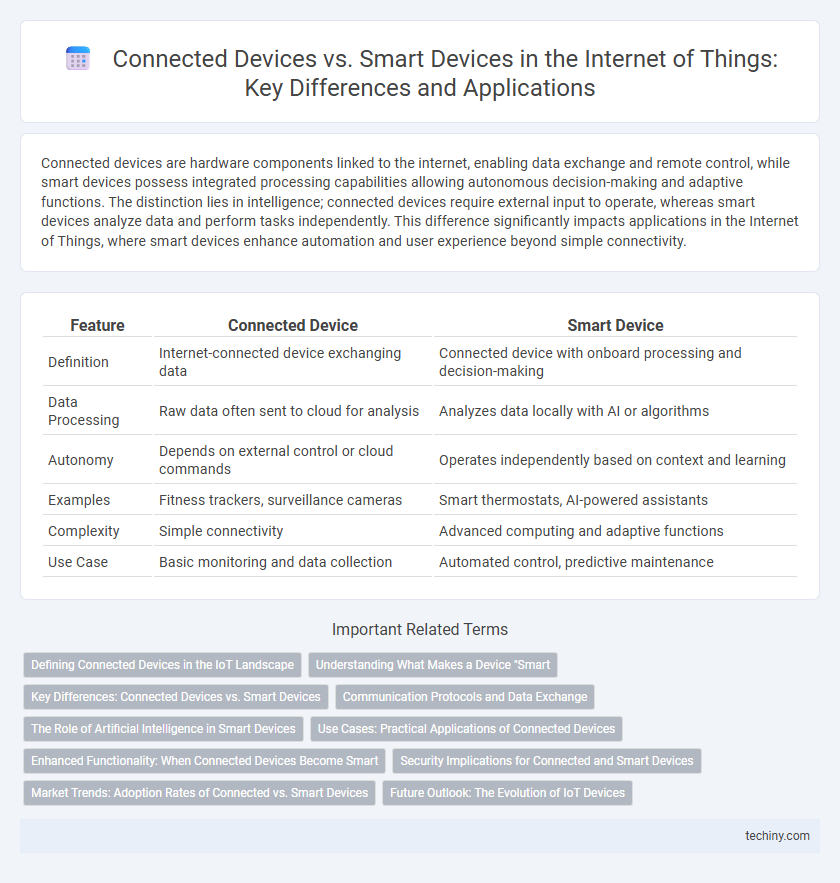Connected devices are hardware components linked to the internet, enabling data exchange and remote control, while smart devices possess integrated processing capabilities allowing autonomous decision-making and adaptive functions. The distinction lies in intelligence; connected devices require external input to operate, whereas smart devices analyze data and perform tasks independently. This difference significantly impacts applications in the Internet of Things, where smart devices enhance automation and user experience beyond simple connectivity.
Table of Comparison
| Feature | Connected Device | Smart Device |
|---|---|---|
| Definition | Internet-connected device exchanging data | Connected device with onboard processing and decision-making |
| Data Processing | Raw data often sent to cloud for analysis | Analyzes data locally with AI or algorithms |
| Autonomy | Depends on external control or cloud commands | Operates independently based on context and learning |
| Examples | Fitness trackers, surveillance cameras | Smart thermostats, AI-powered assistants |
| Complexity | Simple connectivity | Advanced computing and adaptive functions |
| Use Case | Basic monitoring and data collection | Automated control, predictive maintenance |
Defining Connected Devices in the IoT Landscape
Connected devices in the Internet of Things (IoT) are physical objects embedded with sensors and network connectivity that enable data exchange with other devices or systems over the internet. Unlike smart devices, which incorporate advanced processing and decision-making capabilities, connected devices primarily focus on data collection and communication without autonomous intelligence. Examples include RFID tags, wearable health monitors, and industrial sensors, which serve as the foundational components for IoT ecosystems by providing real-time data streams.
Understanding What Makes a Device "Smart
A connected device simply links to the internet or other networks to transmit data, while a smart device incorporates advanced processing capabilities and AI to analyze data, learn from patterns, and make autonomous decisions. Smart devices, such as smart thermostats or intelligent security cameras, enhance user experience by adapting to behaviors and optimizing performance without manual input. The core distinction lies in the device's ability to act independently and improve functionality through machine learning and real-time feedback.
Key Differences: Connected Devices vs. Smart Devices
Connected devices simply link to the internet or other networks for data exchange, while smart devices possess the capability to process data locally using embedded intelligence and algorithms. Smart devices often include sensors, actuators, and machine learning functions, enabling autonomous decision-making and adaptive responses. Connected devices rely heavily on external systems for functionality, whereas smart devices integrate connectivity with advanced analytics for enhanced user interaction and operational efficiency.
Communication Protocols and Data Exchange
Connected devices primarily rely on basic communication protocols like Wi-Fi, Bluetooth, or Zigbee to transmit raw data to centralized systems for processing. Smart devices incorporate advanced protocols such as MQTT and CoAP, enabling efficient, low-latency bi-directional communication and edge computing capabilities. This distinction allows smart devices to perform local data analysis and make autonomous decisions, enhancing the overall effectiveness of Internet of Things ecosystems.
The Role of Artificial Intelligence in Smart Devices
Smart devices leverage artificial intelligence to analyze data, learn user preferences, and make autonomous decisions, enhancing functionality beyond mere connectivity. Unlike connected devices that primarily transmit data, smart devices employ AI algorithms to optimize performance, automate tasks, and provide predictive maintenance. Integrating AI enables smart devices to deliver personalized user experiences and improve operational efficiency within Internet of Things ecosystems.
Use Cases: Practical Applications of Connected Devices
Connected devices in the Internet of Things enable practical applications such as remote monitoring of industrial equipment, real-time asset tracking in logistics, and environmental sensing for smart agriculture. These devices primarily gather and transmit data without extensive local processing, facilitating improved decision-making and operational efficiency. Unlike smart devices, connected devices focus on seamless connectivity and data flow to support automated reactions and analytics in various sectors.
Enhanced Functionality: When Connected Devices Become Smart
Connected devices primarily gather and transmit data through internet connectivity, enabling remote monitoring and control. Smart devices enhance this functionality by integrating advanced processing capabilities, artificial intelligence, and machine learning to analyze data, make autonomous decisions, and adapt to user behavior. This transformation from simple connectivity to intelligent interaction significantly improves efficiency, user experience, and automation within the Internet of Things ecosystem.
Security Implications for Connected and Smart Devices
Connected devices transmit data through networks but often lack advanced security features, increasing vulnerability to cyberattacks and unauthorized access. Smart devices enhance connectivity by integrating AI and automation, requiring robust encryption, regular firmware updates, and secure authentication protocols to mitigate risks from sophisticated threats. Security strategies for both device types must address data privacy, network segmentation, and intrusion detection to protect users and infrastructure effectively.
Market Trends: Adoption Rates of Connected vs. Smart Devices
Market trends indicate that connected devices currently dominate adoption rates with over 75% penetration in consumer households due to their ease of integration and lower costs. Smart devices, featuring advanced AI capabilities and autonomous functionality, are experiencing rapid growth, expected to increase by 22% CAGR over the next five years. Industry analysts project that smart device adoption will surpass connected devices by 2030, driven by rising demand for enhanced user experiences and automated home environments.
Future Outlook: The Evolution of IoT Devices
Connected devices in the Internet of Things (IoT) primarily focus on data collection and communication, enabling basic remote monitoring and control. Smart devices evolve this concept by incorporating advanced artificial intelligence, machine learning, and edge computing capabilities, allowing for autonomous decision-making and adaptive interactions. Future IoT trends forecast a convergence of these technologies, leading to highly intelligent, context-aware ecosystems that enhance automation, efficiency, and real-time responsiveness across industries.
Connected device vs Smart device Infographic

 techiny.com
techiny.com